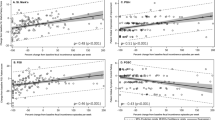Abstract
Introduction and hypothesis
Mobile applications (apps) are becoming an increasingly popular means of obtaining medical information. The aim of our study was to identify and evaluate patient-centered fecal incontinence (FI) mobile apps using a modified APPLICATIONS scoring system.
Methods
We conducted searches in the Apple App and Google Play stores to identify FI-related mobile apps using search terms reflecting both commonly accepted medical terms as well as colloquial terms used by our patients with FI. Apps that were in English, relevant to FI, patient-centered, and medically accurate were included. Each eligible app was then independently evaluated by the three authors using a modified 17-point APPLICATIONS scoring system.
Results
We identified 2785 apps upon initial search using FI search terms. Fourteen apps met eligibility criteria for scoring. Most apps were bowel movement trackers (13/14, 93%), of which only three allowed for tracking of FI episodes. Only one (7%) app contained educational information specific to FI. Ten (71%) apps were fully functional at no cost. Thirteen (93%) apps cited literature. Median APPLICATIONS score was 10 (IQR 9–11). “BristolStoolChart,” “FreeToBe,” and “PoopLog” each received the highest total score of 13.
Conclusions
Patient-centered mobile apps that provide FI-specific educational information or allow for FI symptom tracking are scarce. While we did discover some accurate sources of information and means of tracking bowel habits, patients are likely to encounter inaccurate or irrelevant information even when searching for FI-related apps using appropriate terminology. Future app development should include FI-specific symptom tracking and educational information from reputable sources.

Similar content being viewed by others
References
Pew Research Center. Mobile Fact Sheet. June 12, 2019. Available at: http://www.pewinternet.org/fact-sheet/mobile. Accessed 27 Aug 2020.
Donny Kristianto. Mobile apps usage reached an all-time high amidst stay-at-home measures due to COVID-19 pandemic. Jul7 8, 2020. Available at: https://www.appannie.com/en/insights/market-data/mobile-app-usage-surged-40-during-covid-19-pandemic/. Accessed 1 Sept 2020.
Bates DW, Landman A, Levine DM. Health apps and health policy: what is needed? JAMA. 2018;320(19):1975–6.
Powell AC, Landman AB, Bates DW. In search of a few good apps. JAMA. 2014;311(18):1851–2.
Statista. Matej Mikulic. Global mobile health app downloads 2013–2017. Oct 15, 2019. Available at: https://www.statista.com/statistics/625034/mobile-health-app-downloads. Accessed 3 Oct 2020.
Lee DD, et al. Willingness of women with pelvic floor disorders to use mobile technology to communicate with their health care providers. Female Pelvic Med Reconstr Surg. 2019;25(2):134–8.
Leme Nagib AB, et al. Use of mobile apps for controlling of the urinary incontinence: a systematic review. Neurourol Urodyn. 2020;39(4):1036–48.
Bernard S, et al. Mobile technologies for the conservative self-management of urinary incontinence: a systematic scoping review. Int Urogynecol J. 2020;31(6):1163–74.
Asklund I, et al. Mobile app for treatment of stress urinary incontinence: a randomized controlled trial. Neurourol Urodyn. 2017;36(5):1369–76.
Markland AD, et al. Factors impacting quality of life in women with fecal incontinence. Dis Colon Rectum. 2010;53(8):1148–54.
Brown HW, et al. Accidental bowel leakage in the mature women's health study: prevalence and predictors. Int J Clin Pract. 2012;66(11):1101–8.
Whitehead WE, et al. Fecal incontinence in US adults: epidemiology and risk factors. Gastroenterology. 2009;137(2):512–7 517 e1–2.
Whitehead WE, et al. Treatment of fecal incontinence: state of the science summary for the National Institute of Diabetes and Digestive and Kidney Diseases workshop. Am J Gastroenterol. 2015;110(1):138–46; quiz 147.
Naliboff BD. Choosing outcome variables: global assessment and diaries. Gastroenterology. 2004;126(1 Suppl 1):S129–34.
Stone AA, et al. Patient non-compliance with paper diaries. BMJ. 2002;324(7347):1193–4.
Kamerow D. Regulating medical apps: which ones and how much? BMJ. 2013;347:f6009.
Kadam-Halani PK, et al. The quality of health information available on the internet for patients with fecal incontinence. Female Pelvic Med Reconstr Surg. 2019;25(2):120–4.
Barnes KL, et al. Evaluation of smartphone pelvic floor exercise applications using standardized scoring system. Female Pelvic Med Reconstr Surg. 2019;25(4):328–35.
Sudol NT, et al. In search of Mobile applications for patients with pelvic floor disorders. Female Pelvic Med Reconstr Surg. 2019;25(3):252–6.
The International Urogynecological Association (IUGA) patient leaflets. Available at: http://www.iuga.org/?page=patientleaflets. Accessed 1 Sept 2020.
Haylen BT, et al. An international Urogynecological association (IUGA)/international continence society (ICS) joint report on the terminology for female pelvic floor dysfunction. Neurourol Urodyn. 2010;29(1):4–20.
Chyjek K, Farag S, Chen KT. Rating pregnancy wheel applications using the APPLICATIONS scoring system. Obstet Gynecol. 2015;125(6):1478–83.
Moglia ML, et al. Evaluation of smartphone menstrual cycle tracking applications using an adapted APPLICATIONS scoring system. Obstet Gynecol. 2016;127(6):1153–60.
Perry R, Lunde B, Chen KT. An evaluation of contraception mobile applications for providers of family planning services. Contraception. 2016;93(6):539–44.
Wallace SL, et al. In search of Mobile applications for Urogynecology providers. Female Pelvic Med Reconstr Surg. 2019;25(6):439–42.
Aungst TD, et al. How to identify, assess and utilise mobile medical applications in clinical practice. Int J Clin Pract. 2014;68(2):155–62.
Lewis SJ, Heaton KW. Stool form scale as a useful guide to intestinal transit time. Scand J Gastroenterol. 1997;32(9):920–4.
Andy UU, et al. The relationship between fecal incontinence, constipation and defecatory symptoms in women with pelvic floor disorders. Neurourol Urodyn. 2017;36(2):495–8.
Whitehead L, Seaton P. The effectiveness of self-management Mobile phone and tablet apps in long-term condition management: a systematic review. J Med Internet Res. 2016;18(5):e97.
Bliss DZ, et al. Self-management of accidental bowel leakage and interest in a supportive m-health app among women. Int Urogynecol J. 2020;31(6):1133–40.
Acknowledgments
Presented at the American Urogynecologic Society PFD Week 2020, Short Oral Presentation, October 10, 2020.
Author information
Authors and Affiliations
Corresponding author
Ethics declarations
Conflict of interest
M Vega: No conflicts of interest to declare.
ER Mckay: No conflicts of interest to declare.
PK Halani: No conflicts of interest to declare.
Additional information
Publisher’s note
Springer Nature remains neutral with regard to jurisdictional claims in published maps and institutional affiliations.
Rights and permissions
About this article
Cite this article
Vega, M., Mckay, E.R. & Halani, P.K. Evaluation of mobile applications for patients with fecal incontinence using a modified APPLICATIONS scoring system. Int Urogynecol J 32, 2529–2536 (2021). https://doi.org/10.1007/s00192-021-04918-4
Received:
Accepted:
Published:
Issue Date:
DOI: https://doi.org/10.1007/s00192-021-04918-4




